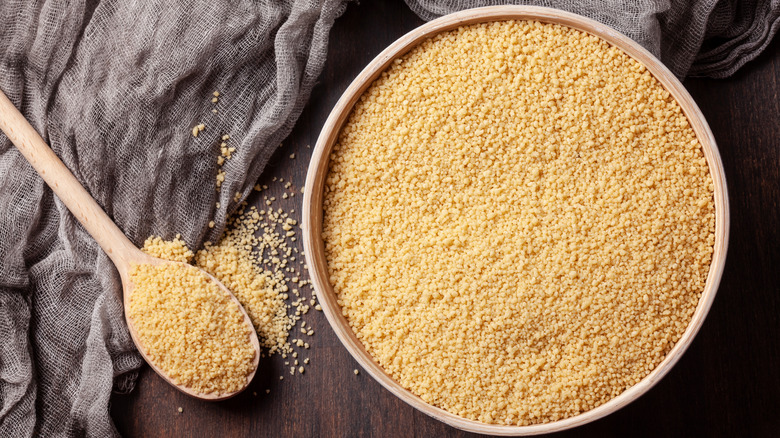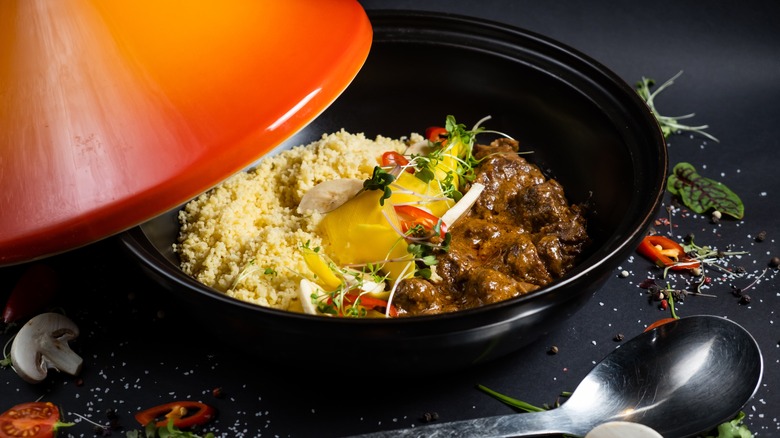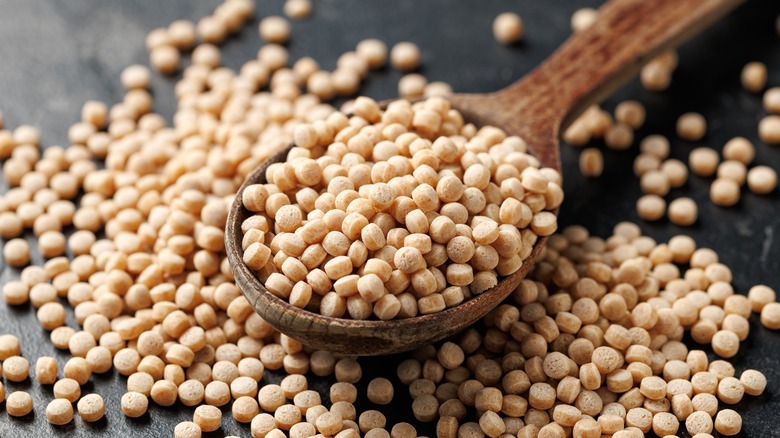Why Couscous Doesn't Actually Count As A Grain
If you're shopping for couscous in the supermarket, it's quite possible you'll find it alongside products like oats, rice, and barley. But in this situation, couscous is technically the odd one out — it's not really a grain like these products. Rather, it's closer to pasta, at least in terms of its ingredients and production method.
It's not hard to find references to couscous as a grain. However, you'd need to take a look at what constitutes an actual grain. In scientific terms, grains are seeds or fruits that come from various cereal crops — these can be anything from sorghum to quinoa or rice. (To back up a little more, "cereal" is just a broad term referring to crops in a broad family of grass plants that are grown by humans to harvest seeds.) There's some ambiguity about whether grains are technically the seeds of these plants or the fruit with the seeds inside. No matter where the line is drawn, couscous doesn't fit into this category.
Grains like rice and quinoa are more or less only the seeds or fruits that come directly from the crop, without any extra ingredients. When harvested, grains may be milled to get rid of difficult-to-eat parts like husks), but there are no extras added in. On the other hand, couscous is made with flour and water. Of course, flour is often just ground grains like wheat, but it's not technically a grain on its own; You could call it a "grain product", though. Hence, couscous is closer to a flour-based product like pasta than a grain.
How couscous is made
This North African staple is a pretty simple concoction. It's basically just semolina flour and water, perhaps with some salt added for seasoning. Semolina is a flour made from durum wheat, a "hard" variety of wheat, meaning that it's high in gluten and tends to be best used for firmer products like pasta compared to soft wheats used for lighter items like baked goods. It's particularly common in Italian cooking, but also crops up in other Mediterranean cuisines. That's where couscous comes in.
Couscous is made with semolina flour that's lightly moistened and rolled into little grains or balls. It's then left to dry before cooking. The couscous you buy at the supermarket is typically an instant variety, so it's been partially steam-cooked to speed up the process when you get it into your kitchen.
The exact cooking time of couscous depends on which type you have. The wet semolina flour can be rolled into different sized balls. The ultra-fine couscous that you might serve with a tagine is the Moroccan variety, and it usually cooks quickly with just a little boiling water added. You can also get larger varieties where the individual balls are big enough to bite into. This is often called pearl or Israeli couscous. Even larger is Lebanese couscous, although it's a little less common in the U.S. These two larger varieties require a longer cooking time, immersed in boiling water — like pasta.
Is couscous pasta or pasta-adjacent?
It seems pretty clear that couscous is not a grain, but there's potentially room for debate as to whether it's a pasta. Since the term "pasta" is near-ubiquitously associated with Italian cuisine — and couscous is predominantly North African — perhaps you could say couscous is "pasta-like" but in its own special, third category. You can see a similar mechanism at work in East Asian cuisine, where the term "noodles" is often used for products that are very similar to pasta in both ingredients and production.
That said, couscous is still pretty darn similar to pasta. Pasta is frequently made with exactly the same ingredients — semolina flour and water (although it can sometimes include eggs and olive oil). And while pasta tends to be in larger pieces, there are also small pasta varieties like fregola, which is near-identical to couscous, particularly the larger pearl variety. There's also pastina, a pasta so small it resembles the fine Moroccan couscous. Add these factors up, and couscous is realistically more under the pasta umbrella than not.
Finally, there's one product that's similar to couscous — Bulgur. It can be confused with couscous since it has a similar size and texture, but it's made from cracked wheat grains. It tends to be used more in the Middle East than North Africa, and is definitively a grain, not a pasta like couscous.


